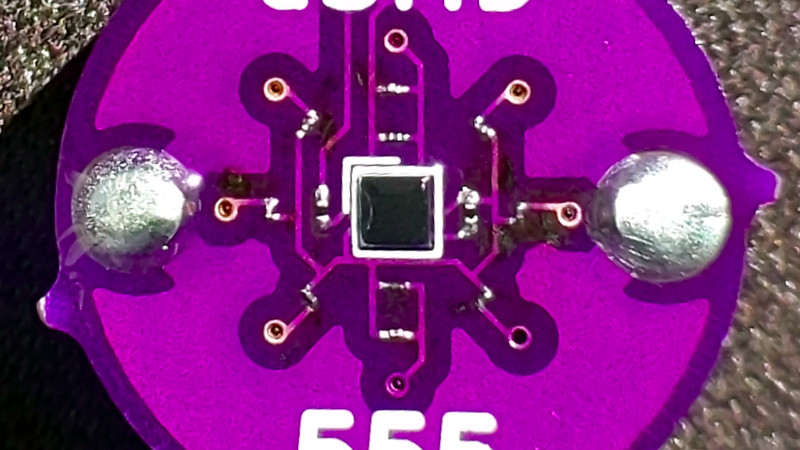A highlight of last year’s Hackaday Remoticon was a soldering competition that had teams from around the world came together online and did the well-known MakersBox SMD Challenge kit in which a series of LED circuits of decreasing size must be soldered. The Hackaday crew acquitted themselves well, and though an 01005 resistor and LED certainly pushes a writer’s soldering skills to the limit it’s very satisfying to see it working. Lest that kit become too easy, [Arthur Benemann] has come up with something even more fiendish; his uSMD is a 555 LED flasher that uses a BGA 555 and a selection of 008004 small components.
The trick with an 01005 is to heat not the tinned and fluxed solder joint, but the trace leading up to it. If components of that size can be mastered then perhaps an 008004 isn’t that much smaller so maybe the same technique might work for them too. In his tip email to us he wrote “Soldering 008004 isn’t much worse than a 0201, you just need magnification“, and while we think he might be trolling us slightly we can see there’s no reason why it shouldn’t be do-able. Sadly he doesn’t seem to have made it available for us to buy and try so if you want to prove yourself with a soldering iron you’ll have to source the PCBs and parts yourself. Still, we suspect that if you are the type of person who can solder an 008004 then that will hardly be an onerous task for you.
Meanwhile this isn’t the first soldering challenge kit we’ve brought you, and of course if you’d like to hone your skills you can find the MakersBox one on Tindie.















There’s a BGA version of the 555?! Didn’t know that…
That’s not a BGA. That’d be too easy. It’s a CSP.
Actually, it’s both. The LMC555CTPX/NOPB comes in a DSBGA or die-sized BGA package which is BGA mounting technology with the wonderful smallness of a chip-scale package.
I can *just* about do 0201, but it takes so much effort and time and I can’t do it reliably. I’d say it’s more down to luck and stubbornness than skill.
For my own projects, I just choose to use 0603 or bigger these days and generous spacing; the results won’t impress anyone with their compactness, but it certainly saves a ton of time and nerves.
You young’uns and your 0603. Us old farts cling to 0805.
Back when I was your age, all we had were 1206s, and we had to solder them with a wood-fired soldering iron!
Bah, when I was young we only had wire wrap and had to pour solder from bucket. And we had to make our own wires from raw copper!
I gave up a long time ago and went reflow all the way on everything. With the right (manual) pnp tools and good magnification it’s outright easy to work with 0402 and 0201. The only thing about 0201 and below is that the requirements for solder paste type, stencil and application method go up a lot. 0402 is still doable without much concern for those parameters. The next level of awesomeness will be the day when the usual board houses start offering embedded 01005 passives.
Al link to a past Hackaday article seems relevant here:
https://hackaday.com/2019/03/25/the-worlds-fastest-555-timer-and-the-state-of-the-555/
Soldering 01005 is easy enough, you just need to use appropriate tools. Minimum requirement is a binocular microscope, solder paste, VERY sharp tweezers, and a hot air rework station. Soldering with an iron is possible with sharp tips, but a terrible idea. Using a solder spool for anything at this scale is right out.
You shouldn’t use these microscopic sizes if you don’t need to, but the wailing and gnashing of teeth is a little overblown. Paste it, place it, reflow it, done. Same as any other smd.
Agree with most points. But I used a soldering iron as described in the article, otherwise the airflow blows the components away even with good tacky flux. Once in place hotair helps align them. For tweezers I used a generic one, but sharpened it in a stone first.
Yes, none should use these components unless necessary. If not for any of the other reason, they cost at least double.
Use x2/x4 passive (R/C) arrays. They are a lot easier to handle, less parts to place and can pack even closer than individual parts.
I’m currently doing 01005’s at work. To do it I use a hot plate and a JBC soldering station using the two soldering pencil trick. The JBC has a really fine tip.
The best I’ve been able to do so far was solder over a tiny 0 Ohm resistor on a Surface Pro 4 motherboard. I used my Canon M50 with a telephoto lens mounted face to face with another lens to achieve the magnification and pumped the HDMI out through to a 32in tv right in front of me. Worked really well
Hot air reflow is the way to go. With some fresh solder paste on each pad and the chip popped on top I am amazed how powerful surface tension is at small scale. What looks like a dog’s dinner before heat, now it’s straightened out and woks. Smallest part so far is 3pin CSP in 0402 size.